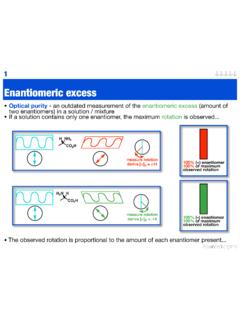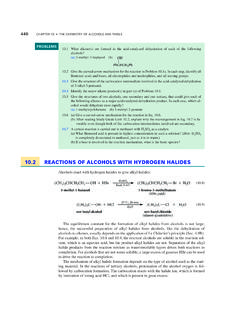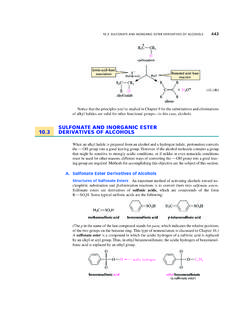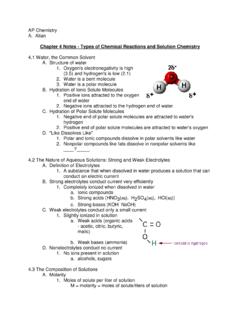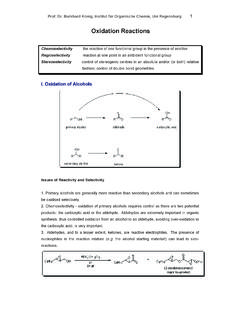Transcription of FREE RADICAL REACTIONS IN ORGANIC …
1 Gareth Rowlands Ar402, Strategy in Synthesis1 free RADICAL REACTIONS IN ORGANIC SYNTHESISMECHANISM Before we look at free RADICAL chemistry a quick revision of mechanisms (again) You should all be happy withCO2 EtRRCO2 Etpolar reaction nucleophile attacks electrophilecurly arrow represents the movement of 2 e Radicals are one electron species so we cannot use curly arrows Instead use fish-hooks these show the movement of one electronCO2 EtRRCO2Et2e 1e need 2 e to form new bond Diagrams can get quite confusing so they are normally simplified to show electrons only moving in one direction BUT remember the above is "more accurate"CO2 EtRRCO2 Etsimplification Note - we are nolonger looking at proton removal but hydrogen abstraction (it still has its 1 e )ROHBrROHBrROHBrROHB rdeprotonationhydrogen abstractionINTRODUCTION The last 10 15 years have seen the development of free RADICAL chemistry in ORGANIC synthesis Major obstacle is the ability of radicals to react with themselves Overcome by only having a very low concentration of radicals present in a reaction Now there are many ways to use these highly reactive species in selective (& synthetically useful) ORGANIC REACTIONS Good example is the RADICAL chain process for allylic halogenationRR8 RRRRNBrOOBrBrh or heat / (BzO)2activated C-Hproblem of isomerisationGareth Rowlands Ar402, Strategy in Synthesis2 RADICAL Chain MechainsmNBrOOh or heat / (BzO)
2 2 NOOBrBrHRBrHRRBrBrRBrBrInitiationPropaga tion chain reaction as chain carrier regenerated The use of NBS rather than Br2 allows controlled formation of Br2 and provides a mechainsm to remove HBrNBrOOHBrNHOOBrBrIonicSelectivity in free RADICAL REACTIONS : Tributyltin Hydride Methodology C-H bonds very strong so need to be activated Strength of bond often prevents chain reaction Major problem is often the selective activation of a specific C-H bond The following reduction reveals a route to overcome this problemRBrRHBu3 SnH, AIBN ( ), PhH, refluxMechanism: Another RADICAL chain reactionNNNCCNNCNNBu3 SnHCNCNHBu3 SnBu3 SnBrRBu3 SnBrRRBu3 SnHBu3 SnHRInitiationPropagationAIBN is an initiator regeneration of chain carrier Chain termination by variety of processes Relative rates of each process allow selective formation of carbon centred RADICAL Tributyltin (TBT) propagates chain C-Br bond weakGareth Rowlands Ar402, Strategy in Synthesis3 SYNTHETIC APPLICATION OF CARBON CENTRED RADICALSI ntermolecular Addition REACTIONS TBT generates synthetically useful radicals Addition reactionsICO2 RTBTH, AIBN,HeatCO2RR1 ICO2 RTBTH, AIBN,HeatR1CO2R C-I good as weakelectron deficient alkene so RADICAL nucleophilicRO2 CCO2 RClR1 OSiR3"TBTH, AIBN,HeatRO2 COSiR3"R1RO2C C-Cl normally too strongEWG stabilise RADICAL so readily formed.
3 Make RADICAL electron deficient so electrophilicelectron-rich alkene NOTE: radicals can be both nucleophilic and electrophilicIntramolecular Addition: RADICAL Based Ring-Formation REACTIONS free radicals are very useful for the preparation of rings RADICAL REACTIONS readily form 5 membered rings Formation of 5-ring takes place under kinetic control (energy of transition state for the formation of 5-ring lower than that for 6-ring)BrTBTH, AIBN,HeatVinyl Radicals More reactive (less stable) than alkyl radicals Generate by the normal methodology (TBTH, AIBN) Normally only used in intramolecular REACTIONS (problems of dimersiation with intermolecular)Gareth Rowlands Ar402, Strategy in Synthesis4 EEBrTBTH, AIBN,HeatEEEENote: geometry of vinyl halide unimportant as RADICAL can invertAryl RadicalsOCH3 IOTBTH, AIBNOOCH3 Aryl radicals are very reactiveOther Precursors: Sulfides and Selenides Just as useful as halides (and frequently give better yields)NRSPhOTBTH, AIBN,HeatNORSePhOOTBTH, AIBN,HeatOther Precursors: Alcohol Derivatives Deoxygenation of alcohols a good method for preparing carbon-centred radicals Good for primary and secondary alcohols but not for tertiary (3y radicals less stable)OSSRTBTH, AIBN,HeatOSSRSnBu3 SnBu3Bu3 SnSSROHSnBu3 HHxanthateoxalate Works with tertiary alcoholsNSOOOOHSPhNSSRSR2 x CO2behaves like halideforms acyl radicaldriving force is strrength of C=O bondGareth Rowlands Ar402, Strategy in Synthesis5 Other Precursors.
4 Multiple Bonds Utilise the addition of a RADICAL to a multiple bond as the propagating step (also incorporates further functionality into the molecule)TBTH, AIBNSnBu3 PhSH, AIBNSPhEFFICIENCY IN RADICAL REACTIONS Normally chain propagation step is the abstraction of H from TBTH Waste of a RADICAL as reduced C-X to C-H So chain transfer REACTIONS developedGroup or Atom Transfer: HalogenIE(Bu3Sn)2, h EINote: all atoms in SM are in productMechanismBu3 SnSnBu3Bu3 SnBu3 SnIEEEIEII nitiationPropagation iodine transfered in propagation stepcatalytic initiatorvinyl halide useful productGareth Rowlands Ar402, Strategy in Synthesis6 RADICAL Based Sequences: Multiple Bond Formation Radicals readily lend themselves to the formation of a number of bonds in one step Tandem Cyclisations Sequenced ReactionsOOClBrTBTH, AIBNHOOC lonly C-Br bond homolysed two 5-exo cyclisationsOOOOOOOOOII(Bu3Sn)2 intermolecular intramolecular atom transferWhat have we learnt?
5 RADICAL REACTIONS very versatile Can be very efficient Good for ring formation Atom transfer allow functional group incorporation Readily used to form a number of bonds in one st
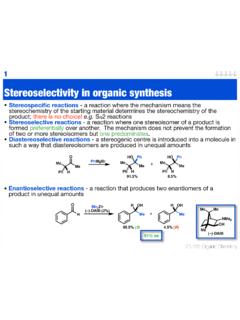
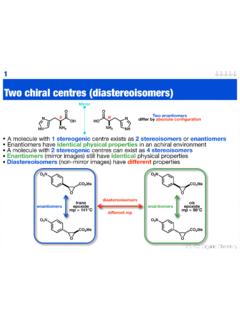
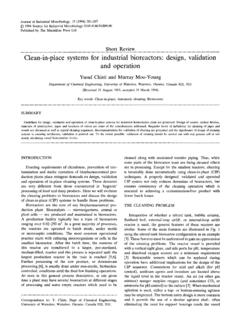

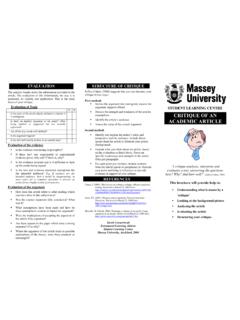
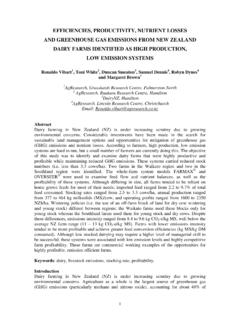
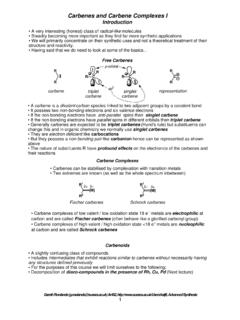
![[3,3]-Sigmatropic rearrangements - Massey University](/cache/preview/0/2/0/3/3/7/7/a/thumb-0203377a43e519e583835c335072f8b8.jpg)
